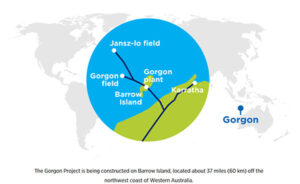What is the Gorgon Project?
The Gorgon Project is a plan to extract natural gas from two large gas fields in the waters off Western Australia, transport it to a specific island for processing, then supply a portion to the domestic market and export another portion as liquefied natural gas (LNG) overseas. This project is centered around the Gorgon and Jansz-Io gas fields discovered by Chevron Australia in 1981 and 2000, respectively. The Gorgon gas field is estimated to contain about 12.0 trillion cubic feet of gas and approximately 87 million barrels of condensate (a liquid hydrocarbon similar to light oil), while the Jansz-Io gas field is believed to have about 14.7 trillion cubic feet of gas and approximately 71 million barrels of condensate.
The project involves transporting the gas via pipeline to Barrow Island, located about 60 km off the coast of Western Australia, where it will be appropriately processed. A part of the gas will be supplied to the domestic market in Australia, and the remainder will be exported as LNG. In August 2009, environmental permits necessary for the development of these gas fields and the construction of gas processing and liquefaction facilities were obtained, and the final investment decision for the project was made in the following month. The plan is to produce and supply LNG for 40 years from the start of production.

Who are participating in the Gorgon Project?
The Gorgon Project involves major corporations such as Chevron, ExxonMobil, and Shell, in addition to Japan’s leading utility companies JERA, Osaka Gas, and Tokyo Gas, who are the world’s largest LNG buyers, participating under a joint operating agreement as equity holders in the gas field and LNG facilities.
The list of joint venture partners and their equity shares are as follows:
| Joint Venture Partner | Parent Company | Equity Share | Acronym |
|---|---|---|---|
| Chevron Australia Pty Ltd – Operator | Chevron | 17.75% | Chevron |
| Chevron (TAPL) Pty Ltd | Chevron | 29.58% | Chevron |
| Osaka Gas Gorgon Pty Ltd | Osaka Gas | 1.25% | Osaka Gas |
| Tokyo Gas Gorgon Pty Ltd | Tokyo Gas | 1.00% | Tokyo Gas |
| Jera Gorgon Pty Ltd | Jera | 0.42% | JERA |
| Mobil Australia Resources Co Pty Ltd | ExxonMobil | 25.00% | EM |
| Shell Australia Pty Ltd | Royal Dutch Shell plc | 25.00% | Shell |
Importance of Carbon dioxide Capture and Storage
Carbon Dioxide Capture and Storage (CCS) is a technology designed to reduce carbon dioxide (CO2) emissions from industrial processes and fossil fuel power generation, helping to mitigate climate change. The process involves three main steps:
- Capture: CO2 is separated and captured from industrial and energy-related sources, such as power plants or factories, before it is released into the atmosphere. This can be done through various methods, such as pre-combustion capture, post-combustion capture, or oxy-fuel combustion.
- Transport: The captured CO2 is then compressed and transported, usually via pipelines, to a suitable storage site.
- Storage: The CO2 is stored deep underground in geological formations, such as depleted oil and gas fields or deep saline aquifers, where it is meant to stay permanently sequestered and not enter the atmosphere.
The goal of CCS is to prevent large quantities of CO2 from contributing to global warming by storing it safely and long-term underground. It’s considered one of the many tools needed to reduce global greenhouse gas emissions and is particularly relevant for industries that have few alternatives to carbon-based processes.
Challenges of the Gorgon Project
Protecting Biodiversity on Barrow Island
Barrow Island, a Class A nature reserve, poses significant environmental management challenges for the Gorgon Project. Stringent measures are in place to protect the island’s unique flora and fauna. The project’s environmental management strategies include quarantine procedures unparalleled in the LNG industry, aimed at preventing the introduction of non-native species to the island.
Carbon Management and Greenhouse Gas Mitigation
The Gorgon Project includes one of the world’s largest carbon dioxide (CO2) sequestration initiatives, aimed at reducing greenhouse gas emissions. The project captures CO2 from its gas processing operations and stores it deep underground. However, the effectiveness and long-term viability of this carbon sequestration technique are subjects of ongoing scrutiny and research.
Remote Location and Infrastructure Development
The remote location of Barrow Island presents significant logistical challenges, from the construction of infrastructure to the daily operations of the project. The development of facilities, including the LNG processing plant, accommodation for workers, and port facilities, requires meticulous planning and execution. Supply chain management is critical, with materials and equipment transported from around the world.
Capital Investment and Cost Overruns
Originally, the Gorgon Project was estimated to cost approximately $37 billion USD. However, as the project progressed, this figure escalated, surpassing $54 billion USD. Such cost overruns stem from a range of issues, including logistical challenges, labor costs, environmental protection measures, and the complexity of technology deployment. The remote location of Barrow Island required the development of infrastructure from scratch, significantly adding to the project’s expenses.
The Gorgon Project, with its ambitious scale and technological complexity, embodies the challenges and opportunities of modern energy development. Its success hinges on overcoming environmental, logistical, and technological hurdles, underscoring the importance of innovation, collaboration, and stringent management practices. As the project moves forward, its experiences offer valuable lessons for future large-scale energy projects around the world.



Comments